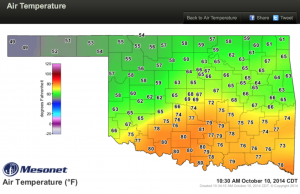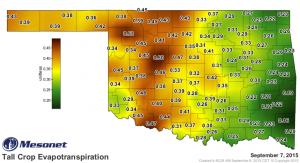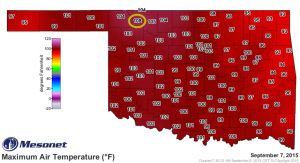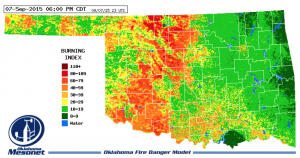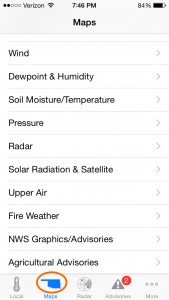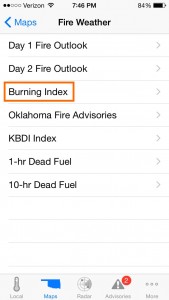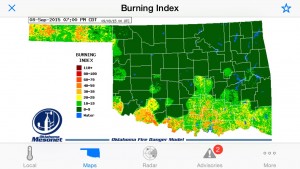The transition time of fall means we need to be ready for hot or cold, wet or dry. We have to think summer one day and more like winter the next. Sometimes, that transition happens within hours.
Fall is a time when the water demand can go super high. The heat drove water demand to high levels on this 2015 Labor Day. In the brown areas, on the map of Tall Crop Evapotranspiration below, a lot of Mesonet sites had water demand rates between 0.4 and 0.5 inches. A half an inch of water demand in one day is huge. Two days like that and your plants need an inch of water. We typically think about providing one inch in a week.
The Tall Crop Evapotranspiration map represents the potential water demand for a well watered crop. It varies from the actual amount, depending on soil moisture and plant species. This gives us an index value related to how much stress our plants are enduring. And it tells us how rapidly soils are losing their soil moisture reserves.
Driving that water demand was a day with lots of heat. Yes, that number in the map below at Freedom is correct, 108 degrees F for a maximum air temperature on this Labor Day, Sept. 7th. That ties this summer’s high back in July, when Buffalo hit 108 degrees F.
Our September 7, 2015 Maximum Air Temperature map had 63 Mesonet locations out of 119 reach or exceed 100 degrees. Another 19 Mesonet sites had an afternoon high of 99 degrees.
A Burning Index map from 6:00 pm September 7th is a good reminder of how fire danger can climb in localized areas, when conditions drive up fire danger. Fire danger weather drivers include: warmer air temperatures, low relative humidities, strong winds, heavy fuel load, and dry fuels.
Monitoring fire danger this fall and winter will be important. The heavy rains in 2015 from late April into July, encouraged lots of plant growth. After our first hard freeze, summer grass stems will die and dry. Grass stems are considered a one-hour fuel. When weather conditions dry out plant material, dead grass stems change to those conditions in about one hour. So just like our jump from hot to cold days, we can jump from wet to dry conditions. We can jump from a day where fire risk is low to one where the risk is high.
If you live in a rural setting, what can you do this fall to reduce wildland fire damage?
You can spend some time considering the fire hazard your property presents. Fire preparation now can help minimize property loss and help keep your family safe.
The Firewise Tips Checklist for Homeowners is a valuable resource to help in assessing the fire risk for rural homes on small acreage.
Firewise is a program developed in California to help those living in rural-urban interface areas to better prepare for the possibility of wildland fires. The main Firewise website provides resources that individuals and communities can use to reduce their wildfire risk.
OSU SUNUP and Oklahoma Gardening have produced some great “Firewise” YouTube videos. Two from 2012 are particularly helpful. The first linked below is a video with Oklahoma Gardening host, Kim Toscano, and Dr. Terry Bidwell, Emeritus Professor of Natural Resource Ecology and Management that covers landscaping and reducing fire risk.
Firewise and home landscaping
https://youtu.be/-8YHbP0R9PA
The second video is with Terry Bidwell, Dr. Keith Owens, OSU Associate Vice President, Oklahoma Agricultural Experiment Station and Dave Deken, SUNUP Producer. They talk about how Keith Owens’ home survived a grass fire that burned right up to it.
What kept the Owen’s home from burning?
https://youtu.be/KMxneCHVZKw
Another resource for checking on fire weather conditions is the OK-FIRE website. You can access it via Mesonet.org and then clicking on Fire Management in the top menu bar. There are fire danger products and online educational resources.
Mesonet fire products are also available on the FREE Mesonet iPhone and Android apps. On the app, go to Maps and then select Fire Weather from the menu. Select Burning Index and then turn your phone sideways to see a larger view of the map.
Select Burning Index and then turn your phone sideways to see a larger view of the map.
For fire, its important to prepare before the flames break-out. And with all the plant growth this spring, it’s important to take precautions this fall.
***Oklahoma Gardening and SUNUP are produced as part of the Oklahoma Cooperative Extension Service’s mission to provide education to all Oklahoma citizens through the Oklahoma State University Division of Agricultural Sciences and Natural Resources.
